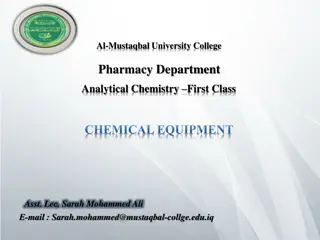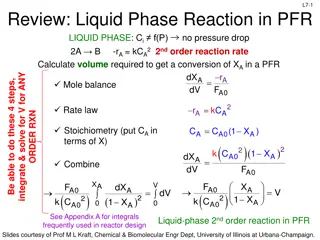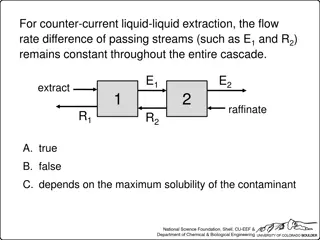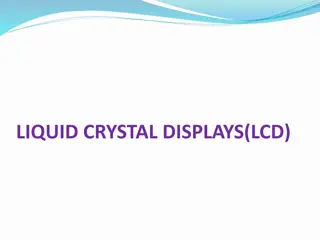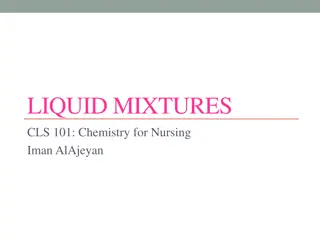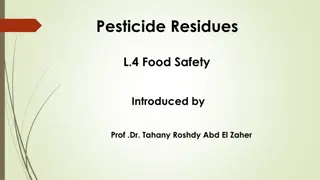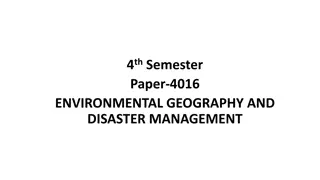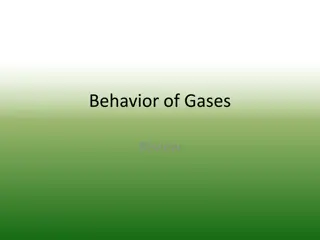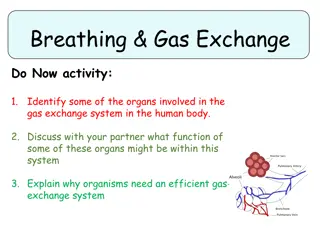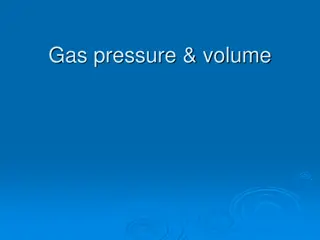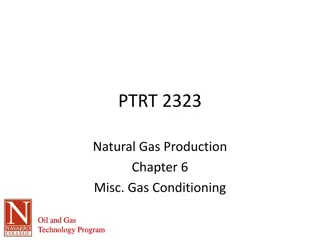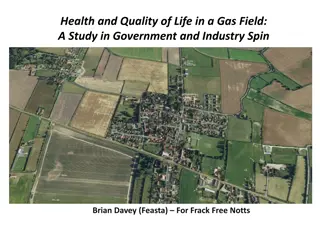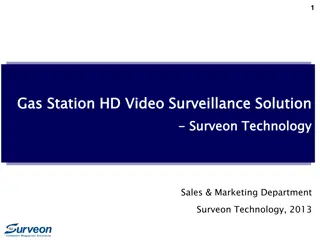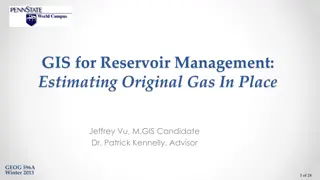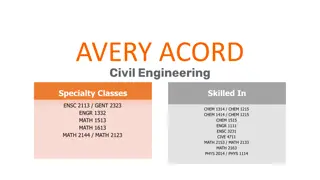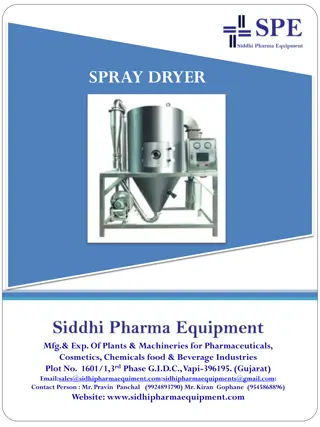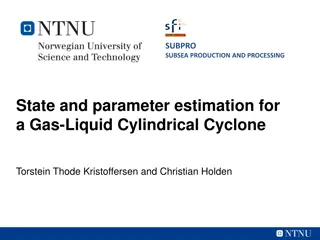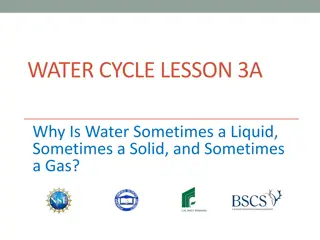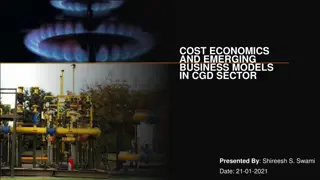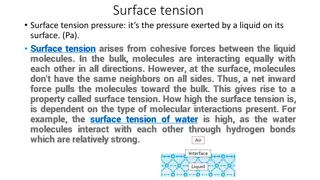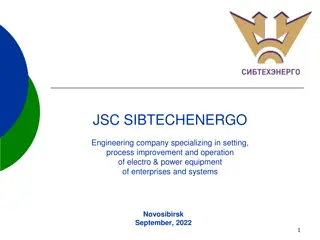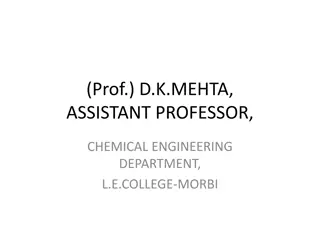Overview of Gas-Liquid Contact Equipment in Chemical Engineering
This content provides an introduction to various gas-liquid contact equipment used in chemical engineering, such as Venturi scrubbers, wetted-wall towers, spray towers, spray chambers, and packed towers. Each equipment type is explained along with its application and operational characteristics.
Uploaded on Sep 12, 2024 | 0 Views
Download Presentation

Please find below an Image/Link to download the presentation.
The content on the website is provided AS IS for your information and personal use only. It may not be sold, licensed, or shared on other websites without obtaining consent from the author. Download presentation by click this link. If you encounter any issues during the download, it is possible that the publisher has removed the file from their server.
E N D
Presentation Transcript
(Prof.) D.K.MEHTA, ASSISTANT PROFESSOR, CHEMICAL ENGINEERING DEPARTMENT, L.E.COLLEGE-MORBI
TOPIC:- Equipments _ Liquid dispersed SUBJECT:-Mass Transfer Operation-I SUBJECT CODE:-3150501
Venturi Scrubber Gas is drawn into the throat of a venturi by a stream of absorbing liquid sprayed into the convergent duct section. The device is used especially where the liquid contains a suspended solid, which would plug the otherwise more commonly used tray and packed towers, and where low gas-pressure drop is required. It is used in the absorption of sulfur dioxide from furnace gases with slurries of limestone, lime or magnesia. The device is also used for removing dust particles from gases.
Wetted-wall towers A thin film of liquid running down the inside of a vertical pipe, with gas flowing either cocurrently or countercurrently, constitutes a wetted-wall tower. This device is used for theoretical studies of mass transfer because the interfacial surface between the phases is readily kept under control and is measurable. Industrially, it is used as absorbers for hydrochloric acid, where absorption is accompanied by a very large evolution of heat. Here device is surrounded with rapidly flowing cooling water. Gas-pressure drop in these towers is probably lower than in any other gas-liquid contacting device, for a given set of operating conditions.
Spray tower and spray chambers The liquid can be sprayed into a gas stream by means of a nozzle which disperses the liquid into a fine spray of drops. In vertical towers flow is countercurrent and parallel in horizontal spray chambers. They have low gas pressure drop. They have relatively high pumping cost for liquids due to the pressure drop through the spray nozzle. Mist eliminator is required because of higher entrainment
Packed tower Packed towers are vertical columns which have been filled with packings. They used for continuous contact of liquid and gas in both cocurrent flow and countercurrent flow. The liquid is distributed over and trickles down through, the packed bed, exposing a large surface to contact the gas.
Characteristics of packings Provide large interfacial surface between liquid and gas. Fractional void volume in the packed bed should be large. Packing must permit passage of large volumes of fluid through small tower cross sections without loading or flooding and with low pressure drop for the gas. Be chemically inert to fluids being processed. Have structural strength to permit easy handling and installation. Represent low cost.
Types of packings (1)Random packings (2)Regular packings
Random packings Random packings are simply dumped into the tower during installation and allowed to fall at random. Rasching rings are hollow cylinders of diameters ranging from to 4 inch or more. Rasching rings are made of chemical stoneware or porcelain are useful in contact with most liquids except alkalies and hydrofluoric acid. Carbon rasching rings are useful except strongly oxidizing atmospheres. They are also made of metals and plastics.
Random packings Lessing rings and others with internal partitions are less frequently used. The saddle-shaped packings are made of chemical stoneware or plastic are available. Pall rings are available in metal and plastic. Telleretes are made of plastic. Random packing offer larger specific surface and larger gas- pressure drop in the smaller sizes, but they cost less per unit volume in the larger sizes. During installation the packings are poured into the tower to fall at random, and in order to prevent breakage of ceramic or carbon packings, the tower may first be filled with water to reduce the velocity of fall.
Regular packings The regular packings offer the advantages of low pressure drop for the gas and greater possible fluid flow rates, usually at the expense of more costly installation than random packing. Stacked rasching rings are economically practical only in very large sizes. Wood grids are inexpensive and frequently used where large void volumes are required. Knitted wire screen, rolled as a fabric into cylinders provide a large interfacial surface of contacted liquid and gas and a very low gas-pressure drop, especially useful for vacuum distillation.
Packed Tower Shells These may be of wood, metal, chemical stoneware, acidproof brick, glass, plastic, plastic- or glass-lined metal, or other material depending upon the corrosion conditions. For ease of construction and strength they are usually circular in cross section.
Packing supports An open space at the bottom of the tower is necessary for ensuring good distribution of the gas into the packing. Thus the packing must be supported above the open space. The support must be sufficiently strong to carry the weight of a reasonable height of packing, and it must have ample free area to allow for flow of liquid and gas with a minimum of restriction. A bar grid can be used but specially designed supports which provide separate passageways for gas and liquid are preferred. They can be made up of metals, expanded metals, ceramics and plastics.
Liquid distributor Dry packing is completely ineffective for mass transfer. spray nozzle is useful. For small towers, a ring of perforated pipe can be used. For large diameters, Weir-trough liquid distributor and many other arrangements can be used. It is necessary to provide at least five points of introduction of liquid for each 1 ft2 of for large towers and greater number for smaller diameters.
Liquid redistributor In case of random packings, the packing density is less in the immediate vicinity of the tower walls, and this leads to a tendency of the liquid to segregate toward the walls and the gas to flow in the center of the tower . This is known as channeling. Liquid redistributor avoids channeling. Knitted mesh packings placed under a packing support make good redistributors.
Packing Restrainers These are necessary when gas velocities are high, and they are generally desirable to guard against lifting of packing during a sudden gas surge. For heavy ceramic packings, heavy bar plates resting freely on the top of the packing may be used. For plastics and other light weight packings, the restrainer is attached to the tower shell.
Entrainment Eliminators Sometimes ,the gas leaving the top of the packing may carry off droplets of liquid as a mist. This mist can be removed by mist eliminators, through which the gas must pass, installed above the liquid inlet. A layer of mesh especially knitted with 98-99% voids, roughly 100 mm thick, will collect virtually all mist particles.
Mass-Transfer Coefficients for Packed Towers Mass transfer rates divided by volume of packings gives volumetric overall coefficients. The overall volumetric coefficients are useful only in the design of towers filled with the same packing and handling the same chemical system at the same flow rates and concentrations as existed during the measurements.
Cocurrent flow of gas and liquid Cocurrent flow of gas and liquid through packed beds is used for catalytic chemical reaction between components of the fluids, the catalyst usually being some active substance supported upon granular ceramic material. Such arrangements are known as trickle-bed reactors. Cocurrent flow can produce no better than one theoretical stage of separation. This is sufficient for substantially complete separation where chemical reaction accompanies the diffusional separation. In this situation flooding is impossible and no upper limit for the permissible flow rates. In the absence of reaction, cocurrent flow is rarely useful.
End effects and axial mixing There will be mass transfer where the liquid is introduced by sprays or other distributors and where it drips off the lower packing support. These constitute the end effects. For proper evaluation of packing itself, correction of experimental data must be made for these effects. Axial mixing reduces the concentration differences for interphase mass transfer. The effect is strong for spray towers and so are relatively poor devices for separation.
Tray Tower Vs. Packed Tower 1. Gas-pressure drop : Packed tower requires a smaller pressure drop. This is important for vacuum distillation. 2. Liquid holdup : Packed tower provides smaller liquid holdup. This is important where liquid deterioration occurs with high temperatures; short holding times are essential and obtaining sharp separations in batch distillation. 3. Liquid/gas ratio : Very low values are best handled in tray tower and high values in packed towers.
Tray Tower Vs. Packed Tower 4. Liquid cooling : Cooling coils are more readily built into tray towers and liquid can more readily be removed from trays. 5. Side steams : These are more readily removed from tray towers. 6. Foaming systems : Packed towers operate with less bubbling of gas through the liquid and are the more suitable.
Tray Tower Vs. Packed Tower 7. Corrosion : Packed towers for difficult corrosion problems are likely to be less costly. 8. Solids present : Neither type of tower is very satisfactory. Agitated vessels and venturi scrubbers are best but provide only a single stage. If multi stage countercurrent action is required , it is best to remove the solids first. 9. Cleaning : Frequent cleaning is easier with tray towers.
Tray Tower Vs. Packed Tower 10. Large Temperature fluctuations : Trays or metal packings are satisfactory. 11. Floor loading : Plastic packed towers are lighter in weight than tray towers, which in turn are lighter than ceramic or metal packed towers. 12. Cost : If there is no overriding consideration, cost is the major factor.








